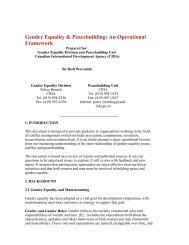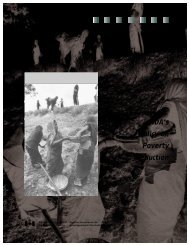Concepts and practices in agricultural extension in developing ...
Concepts and practices in agricultural extension in developing ...
Concepts and practices in agricultural extension in developing ...
- No tags were found...
You also want an ePaper? Increase the reach of your titles
YUMPU automatically turns print PDFs into web optimized ePapers that Google loves.
The environment of <strong>agricultural</strong> <strong>extension</strong> has been chang<strong>in</strong>g with more focus on food <strong>and</strong> nutritionsecurity, poverty alleviation, entry of new actors such as the private sector <strong>and</strong> NGOs <strong>in</strong> the deliveryof <strong>extension</strong> services, changed R&D paradigms <strong>and</strong> bottom–up approaches for end user <strong>in</strong>volvement<strong>in</strong> decision-mak<strong>in</strong>g. However, while the public spend<strong>in</strong>g on <strong>extension</strong> has been shr<strong>in</strong>k<strong>in</strong>g, the role ofgovernment <strong>in</strong> <strong>extension</strong> services delivery is also be<strong>in</strong>g exam<strong>in</strong>ed, sometimes separat<strong>in</strong>g the f<strong>in</strong>anc<strong>in</strong>gof <strong>extension</strong> programs from the delivery of <strong>extension</strong> services. Alongside a new approach has beenemerg<strong>in</strong>g: consider<strong>in</strong>g <strong>extension</strong> as facilitation <strong>and</strong> producers (farmers) as clients, sponsors <strong>and</strong>stakeholders rather than beneficiaries. The key trends reflect global socioeconomic change <strong>and</strong> drivenby key concepts such as participation, client orientation, decentralization as well as developments <strong>in</strong>modern <strong>in</strong>formation <strong>and</strong> communication technology.The design of <strong>agricultural</strong> <strong>extension</strong> programs <strong>in</strong> develop<strong>in</strong>g countries has been the subject of heateddebate. Guided by these debates, <strong>extension</strong> services have undergone several transformations <strong>in</strong> the pastfew decades (Byerlee 1994). In this part of the source book an attempt is made to trace the historicalevolution of <strong>extension</strong> system/services. Then the generic problems of <strong>extension</strong> <strong>and</strong> the steps undertakento address these problems are discussed. The follow<strong>in</strong>g section reviews the various approaches used<strong>in</strong> dissem<strong>in</strong>at<strong>in</strong>g <strong>in</strong>formation <strong>and</strong> knowledge. F<strong>in</strong>ally, the chang<strong>in</strong>g roles <strong>and</strong> emerg<strong>in</strong>g challenges arediscussed.2.2 Historical evolution of <strong>agricultural</strong> <strong>extension</strong>Although <strong>agricultural</strong> <strong>extension</strong> has roots as far back as 1800 BC, formal <strong>extension</strong> <strong>in</strong> most countriesdid not start until the late 1800s AD. The first modern <strong>extension</strong> service was started <strong>in</strong> Irel<strong>and</strong> dur<strong>in</strong>g thepotato fam<strong>in</strong>e <strong>in</strong> 1845 (Swanson et al. 1997). In the United States <strong>and</strong> Canada, formal <strong>extension</strong> starteddur<strong>in</strong>g the late 1800s. France began a national service <strong>in</strong> 1879 us<strong>in</strong>g it<strong>in</strong>erant agriculturists; Japan <strong>and</strong>many of the British colonies also started <strong>extension</strong> services dur<strong>in</strong>g this time.The word <strong>extension</strong> derives from an educational development <strong>in</strong> Engl<strong>and</strong> dur<strong>in</strong>g the second half ofthe n<strong>in</strong>eteenth century. Around 1850s, discussions began <strong>in</strong> the two ancient universities of Oxford<strong>and</strong> Cambridge about how they could serve the educational needs of the rapidly grow<strong>in</strong>g populations<strong>in</strong> the <strong>in</strong>dustrial, urban area, near their homes. It was not until 1867 that a first practical attempt wasmade <strong>in</strong> what was designated as ‘university <strong>extension</strong>’ but the activity developed quickly to becomea well-established movement before the end of the century. The dissem<strong>in</strong>ation of relevant <strong>in</strong>formation<strong>and</strong> advice to farmers however has a long chequered history prior to the emergence of modern formsof <strong>agricultural</strong> <strong>extension</strong> <strong>in</strong> the n<strong>in</strong>eteenth century.In the early years of this century, <strong>extension</strong> services <strong>in</strong> their formative stage were relatively small <strong>in</strong>scale <strong>and</strong> limited <strong>in</strong> the scope of their work <strong>and</strong> contact with farmers, <strong>and</strong> their organization wasoften somewhat haphazard even though based on legislation. They were organized predom<strong>in</strong>antlyeither by central or local governments, or by <strong>agricultural</strong> colleges, usually <strong>in</strong> close association withexperiment stations, or by farmers’ organizations, or comb<strong>in</strong>ations of these parent bodies. As thecentury has progressed, the organizations have matured <strong>in</strong> that changes have often occurred to theirparent affiliations, government fund<strong>in</strong>g has become broader, especially <strong>in</strong> ‘the north’ <strong>and</strong> the <strong>extension</strong>workers have become better tra<strong>in</strong>ed <strong>and</strong> more professional.Fifty years ago, <strong>agricultural</strong> <strong>extension</strong> organizations <strong>in</strong> develop<strong>in</strong>g countries mirrored the adm<strong>in</strong>istrativetraditions of the former colonial powers (Ax<strong>in</strong>n <strong>and</strong> Throat 1972). Like other <strong>agricultural</strong> support services,32





